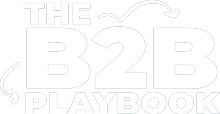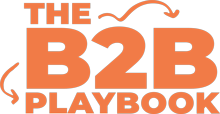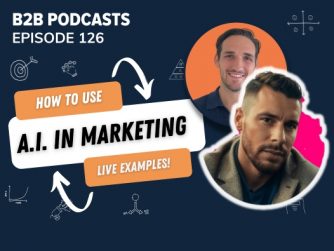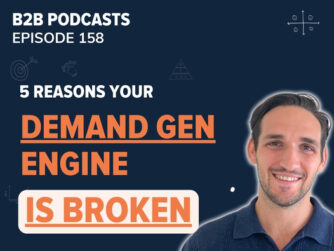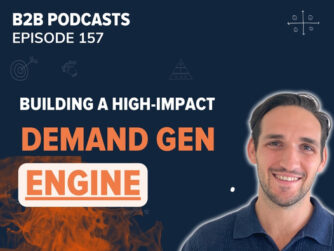This is a guest post from Alan Hale, Founder of Consight Marketing Group™.
I am currently serving as the founder of Consight Marketing Group™ and have spent 40 years in marketing consulting and research for b2b across a wide variety of products and industries. Over 250 projects and have seen some good voice of the customer (VOC) practices, as well as many that were not very good. I wanted to outline a robust process for identifying and acting on b2b voc research insights.
Every now and then on LinkedIn, I will see commentary that b2b is similar to b2c. It is human to human. It is person to person. Nonsense. I could not disagree more.
This white paper/blog will address several areas:
- B2b and why it is different, much different than b2c
- The importance of raving fans
- Using voice of the customer research (voc) to identify insights. Voc is obtaining the customer’s perspective directly from the customer as opposed from getting from a salesperson. It is capturing their voice through methods like face-to-face discussions, phone interviews, surveys, mall intercepts, ethnography observations, focus groups and other methodologies. The insights are used to identify customers wants, needs and expectations for products, services and servicing the account pre-sale, transaction and post sale.
- What to do after the research process
- Other thoughts
Business To Business Is Different
Every now and then on LinkedIn, I will see commentary that b2b is similar to b2c. It is human to human. It is person to person. Nonsense. I could not disagree more.
Let’s define b2b. B2b is not selling to consumers. It can be selling to businesses, contractors, OEM’s, or to distributors and wholesalers who sell to the end use market.
What Are The Characteristics Of B2B?
- There are multiple stakeholders in the decision. An example could be engineering, purchasing and marketing for a bottle manufacturer.
- It is a long selection process heavily influenced by financial criteria like ROI
- Pricing can be very high, even in the millions of dollars
- There is a concept of risk, credibility and trust that must be managed. If you buy the wrong toothpaste, no big deal. If you buy the wrong car, your spouse could get mad. If you buy the wrong solution in in business, you could be fired.
- An existing vendor has the implied trust since they have proven themselves, they have a track record. Actions speak louder than words. It is very difficult to replace a current vendor. If you save 5% and make the switch to a new vendor, and the line shuts down, all hell will break loose. And the plant manager will not get her bonus.
- The 80/20 rule. In b2c like bleach, a consumer will usually buy a bottle at a time unless you are a commercial laundromat. But in b2b, 20% of your customers have 80% of your sales. If you have 200 active accounts, you have 40 that really count. Spend your resources here in trying to prevent churn, and to make them raving fans. This is an extremely important point to remember.
Why You Need Raving Fans
Let’s talk about raving fans, and why they are so important.
Raving fans was coined by Ken Blanchard in a book called Raving Fans. They have the following characteristics:
- They love your company, brand and products. An example is Apple. Look at the long lines when at Apple stores when a new product comes out.
- They are much less likely to defect/churn
- They give you higher wallet share.
- They are generally, although not always, less price sensitive
- They are more likely to buy future products, services and solutions from you, and may even be a beta tester.
- They may be willing to serve on a customer advisory board
- They become brand evangelists rather than brand assassins
- They might, refer you to other customers.
Structuring the VoC research
- Identify your key accounts, the 20% of your accounts who have 80% of your revenue. These are your golden accounts, ie he who has the gold rules.
- Do not try to treat all customers equally, it will destroy your business. You can love everyone, but these key accounts deserve special care.
- Do not try to treat all customers equally, it will destroy your business. You can love everyone, but these key accounts deserve special care.
- Identify key stakeholders at these accounts, both at corporate, the branch and the division. For example it could be purchasing, user/operator, engineering and marketing are examples
You need to drill down to insights, to root causes, then act on them.
You are on your way. Bain Consulting estimates that only 22% of b2b companies obtain and act on the insights obtained.
Executing The VOC Research
- Remember you need to talk to customers, not your salesforce. It is voc – voice of the customer – not vor, voice of the rep. Why would you want filtered and biased input? Many companies want to do this, but it is a sub optimal approach.
- In b2c, you have millions of people who buy bleach as an example. It is important to do quantitative first to tease out opportunities. Then follow up with qualitative methods like focus groups, ethnography, mall intercepts etc. In b2b, it is opposite. You start with qualitative discovery first, then use quantitative to make the data more robust.
- In b2c, you are looking for statistical significance. In b2b you are looking for major insights as you are interviewing into 80% of your sales. You can add prospects who might grow into a large account as well as sample accounts who churned, to make sure you learn what not to do. This is hard concept to understand for research practitioners in b2c research, and they have difficulty shifting their paradigms. Concentrate your research dollars on your key accounts and identifying factors that could make them raving fans.
Customer Research Methodologies
There are a variety of methods. Here are ones frequently used, but are not optimal for b2b.
- Web surveys. They are cheap to administer. It is estimated that about 60% of marketers use this method. It is quick to get results. The problem is that it does not drive insights. Respondents in many cases do not answer the qualitative questions. If they answer these qualitative questions, they will write two or three words. You may get 2% to 15% response rate. We need to have more discussions and less survey slapping. Not getting the whys, the context for the scores and ratings is really marketing malpractice in my view. Yet it continues.
- Focus groups are ok but have several problems. It is difficult to do logistically, get everyone in a room. You have 90 minutes to get the group talking which means probably six to eight questions. And even with good moderators, some respondents will try to dominate, others will be more quiet. And group dynamics will be bad if they compete in the market like a group of distributors. Last the cost is high. Travel, honorariums, recruiting fees, food, video taping, generating transcripts. We like focus groups for new products and new website reactions.
You need to action on these insights. The goal is to make research costs an investment in the business not just a line item cost. It is about ROI and the CEO will be in tune with that.
Our favourite methods are face to face executive interviews and qualitative phone discussions.
- We love face to face executive interviews with maybe 15 key customers. Both the CEO and a marketing person should go out initially. Over time proactively other functions should be included like engineering. The CEO gets to hear first hand with no filters like sales reps, what the customers want and don’t want, where the client should improve. Once they have this vision, it helps drive this level of insight into the DNA of the organization. From a personal observation, you can see their eyes processing this input at the meeting.
- The second methodology we love is in-depth qualitative phone interviews. We get customers to spend about 30 minutes on the phone and have about an 81% response rate. This is normally better from an outside third party as there is no bias. The third party is not trying to force the data to fit a hypothesis. You can compare data between the two groups. It provides group learning. There are a few cases where the inside research and insights group is strong enough to pull this off, but this is the exception.
- Some questions that have proven useful include:
- what do you like
- where do we need to improve
- what are the most important criteria
- what improvements do you want to see in the product
- how responsive are we to post transaction support both customer service and technical support
- how do we compare to the competition
- what should we do more of
- what should we stop doing as it is limited value to you?
- You need to drill down to insights, to root causes, then act on them. Lets walk through an example. How would you rate us on lime delivery on a 1 to 10 scale. I give them a 5. Why did you give them a five? The trucks are late to the loading dock. How often is this? About 60% of the time trucks are late. Why is this an issue? We have a small loading dock and have a lot of trucks on tight schedules. What would you like them to do. The trucks should be on time, and when they know they are running late, they should call us ahead so we can move around truck schedules. Try having that give and take with a web survey. You can’t. The customer has given you a recommended solution to make them happy.
- Write up transcripts for each customer discussion to internalize the learnings into your company.
The NPS System
Some commentary on NPS, the Net Promoter Score now the Net Promoter System. It has gotten a lot of bad press lately because it is not actionable. Web surveys are sent out, but insights are not captured. I have a 26% NPS, now what do I do. Who knows. The score was meant to be a benchmark not the objective of the research. If you add qualitative diagnostic questions you will get the answer on how to improve. Done wrong, and most are done wrong, you have a vanity metric for the CEO but it wont help you transform the business. Done right it is a powerful predictor of who will buy more, who will churn over time. You can take actionable steps to raise the NPS score of each account. I am a strong believer in NPS and have seen remarkable results. But I am not here to convince the multitudes of service providers who think it is not a good methodology.
Use of Quantitative Research
Once the qualitative research is done, you might decide to do quantitative to make the data more robust and to survey other accounts who are not your key accounts. This can be used to tap into other non- key accounts as well as prospects.
Post Research Actions
Ok, that is done, but you are not finished. Now what? You need to action on these insights. The goal is to make research costs an investment in the business not just a line item cost. It is about ROI and the CEO will be in tune with that.
So here is the post research checklist
- Identify the top three to five issues that cut across customers. It could be delivery, it could be lack of responsiveness, it could be difficult to do business with.
- Cascade the communications to the company employees. Here is what we heard. Here is what we are going to do. Every employee as well as key vendors should know the situation and your game plan. Obviously for your key vendors like ad agencies there should be an NDA in place.
- Craft initiatives which address these high priority issues.
- Assign each initiative to a senior level manager for sponsorship. Someone needs to be accountable as well as allocate resources.
- Address the silo issue. The goal is designing processes around the customer.
- Each large account may require specific initiatives in addition to the top three to five identified earlier. Again the goal is to make them raving fans.
- Hand out customer transcripts to the salespeople of their assigned accounts. They should carefully review these documented conversations. Tell the reps what we are doing about it. Train the sales people not to be defensive and learn to take criticism. We have seen role playing with professional actors be very helpful. The last thing you want is a defensive rep verbally attacking a customer.
- Close the feedback loop. This is not a one and done process. Go back to each customer. Here is what we heard. Are we missing anything? What else would you like us to do to make you a raving fan? Here is what we are going to do? We are going to initiate the following programs. We will visit you every quarter, to assess our progress jointly.
- Start a physical war room where each account is, the progress of your initiatives. The CEO or CMO can come in and take a look. When they can see what you are doing, and the progress you are making, they will be more likely to fund.
Final step
As cited early, this is a journey. In 18 months after the initiatives have been launched, have discussions with customers to determine if your initiatives have any impact on your relationship.
Independent of this research you should be proactively reaching out to your customers to understand how you are doing. We recommend a 10/30/90 day program. Every one day every two weeks, marketing should be spending a day with a customer or customers. Every 30 days, engineering should be spending with a customer. What improvements would you like to see in our product? What issues would you like our solution to address? Remember discussions and engagements are much more valuable than survey slapping customers.
Conclusions
The above is a complicated process. It is a change in paradigm that we do not need to do research, we know what our customers want. You don’t. This process identifies insights and helps you focus initiatives on these key insights. You are building a strong customer foundation. The research becomes an investment, not just a line-item cost. The CEO will support you since it is ROI versus collecting some research.
It focuses the organization on the right initiatives, those that make large customers raving fans. It prioritizes your focus. Being busy with a multitude of tactics is not a substitute for building this solid foundation. Yes copywriting, websites, SEO, social media, data analytics, branding are important activities. But these with the exception of branding are tactics. Activities to be done once you understand customer insights, their journey, their experiences etc.
The other positive is that this process is difficult to impossible for competitors to duplicate. After all, they are too busy managing their own activities and don’t have the time to do this process.
I hope this has been valuable. You can look to my LinkedIn profile linkedin.com/in/alanwhale for more information, or visit our website: www.consightmarketinggroup.com
